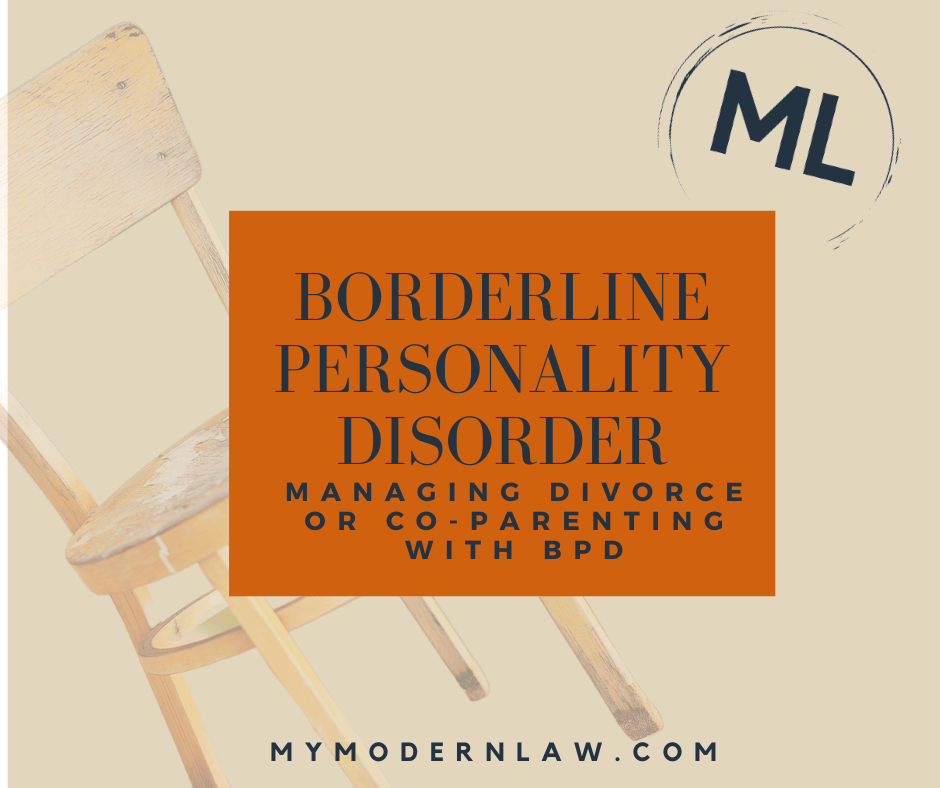Borderline Personality Disorder and Divorce
Divorce or co-parenting is hard without mental illness. If you or the other parent has Borderline Personality Disorder, divorce is more likely and co parenting gets even more complicated.
Borderline personality disorder and other personality disorders can further complicate already difficult relationship issues and make it challenging to navigate personal connections for those afflicted, as well as for those interacting with people who have BPD. Obviously, with a marriage or live-in relationship, the effects are much bigger because of the constant presence of the other person.
Even those who have well-managed conditions may find that they struggle in personal relationships, or that they start to experience personal struggles once relationship conflicts arise. A simple Internet search will offer endless insights, but also endless cautionary tales, regarding BPD and relationships, especially in terms of divorce.
Before we get into how this condition can manifest during or have an impact on divorces and breakups, let’s take the time to learn more about what borderline personality disorder is, what causes it, and what it looks like. We’ll also discuss common treatment options, and the all-too-common issue of avoiding or sabotaging treatment as a symptom of this and other mental health disorders.
What is BPD?
According to the National Institute of Mental Health, borderline personality disorder is a mental illness that is “marked by an ongoing pattern of varying moods, self-image, and behavior. These symptoms often result in impulsive actions […] intense episodes of anger, depression, and anxiety that can last from a few hours to days.”
There are several subtypes of BPD that have been discovered over the years with additional research. However, they all tend to have similar symptoms and the same basic concept of an inability to stabilize emotions and impulse control issues.
People with this condition could be uncertain about their own view of themselves and their place in the world, which can result in quickly changing interests, values, and even fast-and-loose moral decisions that can change on a dime.
Because of all of this impulsiveness and uncertainty, people with BPD have a difficult time developing a sense of self, let alone an ability to form meaningful connections with others. Even when they can, it can sometimes be a challenge for their partner to manage living with the condition and its various effects on day-to-day life.
A Little Background
This condition generally begins or appears during the adolescent or young adult years, and is often found along with anxiety, depression, substance abuse and other impulse control disorders, and other personality conditions. Perhaps the biggest issue, for most, is that the diagnosis of this condition is often overlooked, which can delay or completely prevent recovery.
BPD was officially recognized as a mental health disorder in 1980, which means that it is at least two decades behind the majority of other mental health conditions in terms of research, education, treatment options, and a greater understanding of the condition and how it works. This has created more stigma around this disorder, along with misunderstanding about how it affects people and its causes.
Fortunately, the last few decades have shown some promise and progress for borderline personality disorder. Evidence-based treatments have been found that offer hope for people diagnosed with BPD, but there is still no real “cure” or solution that works for everyone. Like all mental health conditions, it’s largely a balancing act of finding the right treatment plan based on the individual circumstances and condition.
Next, we’ll discuss the symptoms of BPD and signs to look for. After that, you can find out more about the specific types of BPD that people suffer from and what each one entails. First, a few quick facts:
- BPD affects nearly 14 millions Americans (5.9%) at some point in their life.
- 20% of patients admitted to psychiatric units have BPD.
- BPD is 50% more common than Alzheimer’s and affects almost as many people as bipolar disorder and schizophrenia combined.
- About 10% of those in outpatient treatment are being treated for BPD.
What Causes BPD and What Are Its Symptoms?
The causes of borderline personality disorder aren’t fully known, although it is believed that genetics can play a factor. The condition may also be affected by brain structure and social, cultural, or environmental factors, which could increase the risk of developing BPD or the severity of the symptoms. Later, we’ll talk about the three biggest suspected causes, and then we will go over the most common symptoms experienced by those diagnosed with this condition.
Take the time to think about yourself or your partner when reading through this information and see if you can gain any insight to help you deal with the condition both in general, as well as through the divorce process. Your lawyer can help with this, but if you already have ideas in your mind, it will be easier to get a plan together. They can’t know what your experience is like, after all, so you’ll have to tell them.
The three presumed causes or factors involved in borderline personality disorder:
Your Brain
Studies have shown that people who are diagnosed with BPD tend to have functional and structural differences in their brain. These variances are more common in areas responsible for regulating emotions and controlling impulses. It isn’t clear whether these are risk factors for the condition or if they are simply effects caused by the condition, but they offer a promising point of focus.
Your Family History
It has been shown that those who have a family member that suffers from BPD may be more likely to develop the condition than those with no familial connection. This is not necessarily always the case, but there is believed to be some genetic role in the cause of this condition.
Your World
The environment that people live in, as well as their culture and society, could all have an impact on emotional health, including trauma and adversity. Unstable childhood life, invalidated relationships, distrustful adults, and other conflicts or traumatic events can all lead to a variety of mental and emotional issues, including borderline personality disorder, according to the early research that is available.
The Symptoms to Look For
Whether it’s you or your partner that may be suffering from BPD, the list below includes the most common symptoms and signs to watch out for when you think something is amiss.
- Viewing things in extremes, having an “all good” or “all bad” mentality
- Rapidly changing opinions of others, with relationships going from good to bad in a day, or even a matter of hours
- Intense and unstable relationships that result from the shifting feelings and lack of impulse control
- Avoidance of abandonment, whether real or imagined, including cutting themselves off from people as an anticipatory move
- Relationships that swing between extreme closeness and extreme anger or dislike
- Unstable and distorted sense of self or self-image
- Self-harming behaviors
- Suicidal thoughts and ideations
- Impulsive and dangerous behaviors, including substance abuse, unsafe sex, reckless driving, spending sprees, and so forth.
- Intense, rapidly changing moods that can last for episodes of a few hours to a few days
- Inappropriate and intense anger, or difficulty controlling that anger
- Chronic feelings of emptiness and despair
- Feeling dissociated or detached from oneself or reality
- Difficulty trusting others and irrational fears regarding their intentions
There are several symptoms here and not everyone will experience them all. Furthermore, there might be symptoms and signs that aren’t on this list that may also be related to the condition. As we said, it’s still newer in terms of being recognized and researched, so there is much to learn.
The 4 Types of Borderline Personality Disorder
Previously, BPD was segmented into two main categories: Avoidant and Histrionic. Today, however, research has shown that there are actually four subclasses of this condition that people may present with, and each has its own symptoms and reactions to various situations. In order to help you better understand the specific diagnosis of you or your soon-to-be ex, here’s what you need to know.
Quiet BPD
Also known as discouraged borderline personality disorder, this specific type of BPD has a bit of a misleading name. Those who have this type of BPD tend to direct their behaviors and mood swings inward, which is the opposite of most people with this disorder, who tend to direct their emotions and impulse control outwardly. People with this type may be known as “high functioning”, which basically just means that people may not readily show their symptoms externally.
The biggest difficulty with increasing understanding of this condition is when people have types like this where their already difficult emotional balance is further downplayed by the lack of outward symptoms and reactions. People with this condition tend to be filled with self-doubt, internalized rage, self-blame and guilt, anxiety, and emotional attachment issues.
People who have the “quiet” version of BPD will notice symptoms like:
- Suppression or denial of anger and internalized impulses related to that anger
- Withdrawing or avoiding others when you are upset
- Self-blame for conflict
- Poor self-esteem and a sense of guilt or shame about your existence and life decisions
- Feeling like a burden or feeling detached completely from the world around you
- People-pleasing at all costs
- Fears of rejection, abandonment, isolation, and of being alone
- Self-fulfilling prophecies of pushing others away, detaching from connections, and being unable to build connections in the first place
- Having a “thin skin” or tendency to take things too personally
Basically, people who have this type of BPD will have a heavier focus on the internalized part of the condition that fuels guilt, shame, anger, and inward denial of the condition’s existence, in many cases.
This subtype of the condition is part of the reason that there isn’t a lot of information or discussion about BPD– since people with this version try to minimize the external effects, many people might not even know that someone with this form of the condition is even affected in the first place.
This condition can also lead to depression and anxiety, as well as substance abuse or eating disorders as a way to regain control or otherwise deal with the difficult emotions involved. It is more high-risk than others for dangerous behavior because of all of the internalization, as well.
Impulsive BPD
The next subset of this condition is known as impulsive BPD. This refers to the more general disorder that affects the majority of people and is the one that is most commonly related to histrionic personality disorder. This is the type where people are much more extroverted and unable to control impulses. They may display instability in their moods and interactions with others, including symptoms like:
- Charming or flirtatious with others, almost by default or even without realizing it
- Elusive and superficial with others and their relationships
- Easily bored with high energy levels and a lack of focus in many cases
- Risk-taking behaviors with no regard for personal safety or other consequences
- Attention-seeking or overly-dramatic behaviors and moods
- Highly manipulative habits, including manipulating others or putting themselves in the center of attention
- Frequent and not-always true claims and complaints of illness or chronic discomfort, pain, and so forth
Ultimately, people who have this condition are more extroverted about their symptoms and the condition as a whole. Unlike the former subset where guilt and shame ruled the moods, this condition is marked by attention-seeking and extroverted behaviors.
There may be other symptoms and signs of impulsive BPD, but these are the most common ones that have been reported. There may also be general symptoms present and some people may still struggle internally with the guilt, shame, and inability to control their emotions or decisions. However, it will not be as obvious since this condition is marked by more extroverted behaviors that are almost designed to “distract” everyone else from the individual and their symptoms.
It’s not really known how people develop one subset of BPD or another, as the causes of the condition in general are still under investigation. However, it’s likely related to similar causes of the condition in general, such as childhood trauma, brain issues, genetics, and environmental factors, just to name a few.
Self-Destructive BPD
The insecurity and self-loathing of BPD are the highlights of this form of the condition. Self-destructive BPD is generally focused on taking out the irregular and illogical emotions on oneself. The reckless behaviors, impulsive decisions, and sometimes dangerous choices are seen more regularly in this form of BPD than the others.
Self-destructive BPD causes people to make decisions based on irrational information or false facts. They fear being abandoned, so they will cut off all relationships first, or they will manipulate people using their emotions and condition as a way to make them feel guilty or like they “have to stay”.
In some extreme cases and those that border on petulant BPD (which we’ll discuss next), people might use their condition or the symptoms (self-harm, etc.) to manipulate and control others. People may threaten to harm or kill themselves if the other person doesn’t respond accordingly or behave in a way that is acceptable to them.
People may threaten the safety and wellbeing of others as a part of their extreme emotions that they are struggling to regulate. In addition to the main symptoms of BPD, people with the self-destructive type will generally exhibit or experience symptoms like those listed here:
- Self-loathing that leads to poor decision making
- Feelings of bitterness, depression, or that no one cares
- Self-injurious behavior or suicidal thoughts and threats
- Impulsive and poor decision-making, self-sabotage, and high-risk behavior
- Unstable emotions
- Intense lack of self-care ability and unstable self-image
- Substance abuse
- Attention-seeking behaviors
Here, people tend to take the symptoms and false beliefs of BPD out on themselves as a way to deal with the condition or even just as a symptom of the condition itself. Unlike taking it out on others, the emotions are directed inward and deliberately focused on the self-fulfilling prophecy of setting yourself up to fail.
When this condition is present, people believe that no one cares and that they aren’t deserving of the attention anyway. They will use that feeling of a lack of care to justify poor decision making, irrational behaviors, extreme emotions, and other unstable and unpredictable behavior.
Petulant BPD
Petulant BPD is marked by a sense of overwhelming anger and frustration that generally leads people to irrational “if, then” thinking– if you love me, you’ll do this.
If you really care about me, you would…
You’re just going to leave me anyway
How can you prove that you love me?
These are all common thoughts and statements of those with petulant BPD, since their primary focus is on feeling accepted and not being abandoned. The feelings manifest themselves in a sort of self-fulfilling prophecy. Those who have this type of BPD will often push people away and use the “if you love me” type of thinking in their own relationships, which can lead to a host of issues and conflict along the way.
Those who have this type of BPD will see a lot of difficulty in personal relationships and symptoms that reflect those struggles. Their own feelings and BPD symptoms will be handled or taken out on others as a way of dealing or because they don’t know how to regulate and manage their emotions. People who have petulant BPD typically experience symptoms like:
- Inability to express feelings or expressing feelings incorrectly
- Outbursts of anger or anxiety
- A need to control other people
- Social anxiety
- Extreme fear of abandonment and behavior that reflects that fear
- Dissatisfaction in relationships, including a constant high/low or push/pull situation
- Wanting to impose guilt or feelings of shame on others
- Passive-aggressive behavior
- Shutting people out or cutting them off
- Self-harm or self-destructive behaviors
- Using self-harm or suicidal thoughts or behaviors to control others or gain attention
Basically, the people who suffer from this form of BPD are exerting the biggest elements of their condition at other people. They are using others and manipulating situations to their advantage, using their mood swings and anger to control others and the world around them.
At the same time, they’re constantly searching for validation and feeling insecure and full of doubt, which can result in additional anger, guilt, or other feelings that can exacerbate the interactions with others. For example, when you decide on divorce, your soon-to-be ex may feel abandoned and like they aren’t good enough, which could present itself in the form of extreme passive-aggressive behavior, manipulation, and shutting you out entirely.
The difference in shutting others out here is that unlike with quiet BPD, those who suffer from this type will loudly make sure that people know they are being shut out before just cutting them off. They are seeking attention and this is where their impulse control and lack of emotional regulation are displayed.
The Paradox of Treatment Avoidance in Borderline Personality Disorder
Although it is present in other mental health conditions as well, it is most commonly found in BPD that people who are struggling with their mental health will be more likely to sabotage their treatment as a result. This is often seen in various forms, from people avoiding treatment entirely to manipulating their own medications or trying to filter their symptoms as a way to minimize the condition and thereby avoid some types of treatment.
Mental health disorders trick the brain into a lot of things. Thinking that it doesn’t need help is one of the most dangerous for people who need it.
People who suffer from BPD, in all its forms, have a huge sense of shame and guilt about their state of mental health and self-image. They feel like everyone is going to leave them anyway and some even have a lot of high-risk and self-destructive behaviors. Another problem with seeking treatment and getting ongoing support is that the impulse control exhibited by some makes this impossible.
Someone may be on a good path to successful treatment one day, only to impulsively dump all of their medication and quit seeing their therapist the next day due to an irrational decision. This is part of the issue in understanding this condition, as well as in treating it effectively.
It’s hard to help people who are constantly sabotaging themselves. Of course, this is a characteristic of any mental health disorder, even if it isn’t as commonly found in others. The brain is attacking and lying to itself, which includes convincing you that it doesn’t need the treatment that it so desperately deserves.
When situations of high-stress arise, such as a breakup or divorce, these symptoms can become even worse.
Some people might use their treatment as a bargaining tool or a way to manipulate their partner into doing what they want. Others may simply believe that they don’t need treatment, don’t deserve to be “happy”, and so forth. This is also another reason that there is limited information– these people don’t like admitting they have a mental health condition or asking for help in the first place. No wonder it’s hard to study.
How Does BPD Manifest During Divorce and Breakup Situations?
Because of the lack of impulse control and emotional regulation, a borderline personality disorder can manifest (get worse or appear obtrusively) during breakups and divorce with ease. The high stress and emotional turmoil, combined with the dissolving relationship creates a self-fulfilling prophecy for them that, in their minds, ends in that ultimate “abandonment” and proves that they will never be good enough.
Even when someone is high-functioning and thinks that they know how to control themselves or handle their condition, they usually don’t. Divorce is a process that has its own stressors and factors involved that people are often ill-prepared for, and as a result, any emotional or mental health issues tend to appear or become worse throughout the process.
A borderline personality disorder is marked by impulsiveness, unfiltered or unmanaged emotions, and a deep sense of poor self-image and self-worth. A breakup, to these people, could be seen as a huge life failure, causing them to spiral further into their condition, develop extraneous depression symptoms, or even increase their anxiety levels.
Another big indicator of BPD and similar mental and emotional conditions is the inability to self-soothe. This can be difficult in times of stress, often making the condition worse or creating issues with managing BPD for those who are facing it. As the spouse of someone with this condition, it can be frustrating to deal with their constant impulsiveness and self-worth issues, but there is a lot more to it than that.
During breakups and divorce, those with BPD will respond differently, both based on the circumstances and on the type of condition that they have. For example, someone with Quiet BPD might just shut down and internalize everything, falling into a bit of a depression. Someone who has Petulant BPD might try to use their even more unstable emotions as a bargaining chip or a way to manipulate the other spouse involved in the breakup or divorce.
For example, they may become increasingly reactive, insulting, or even threatening to the other person. Someone with BPD might make wild, unfair accusations because they are panicked and feeling abandoned and lost. Their condition causes them to lash out and seek attention and validation.
A divorce could be one of the most invalidating experiences for someone with BPD who just wants to avoid that abandonment that they have feared for years.
It’s going to impact their condition. Of course, to prevent this, people dealing with BPD should make sure that they have an appropriate treatment plan in place. Along with that, it’s important to make a personal plan for handling the stress and getting through the legal process.
Part of that plan should include working with a qualified divorce lawyer that understands the unique effects of divorce on mental health disorders like borderline personality disorder.
Tools to Manage BPD During Your Divorce Case
Of course, regardless of anything else, the best thing that you can do is to have a plan. That plan should include a list of tools that you can use to help manage the condition and its impact on your divorce, a treatment plan for the affected spouse that shows their willingness to improve their state of health and become a better person and parent in any way that they can, and other resources that will help you navigate through the process.
The exact tools that you need will depend on whether you are the one suffering from BPD or if you are dealing with a partner that has the condition. However, it always starts right where you’re at– with education.
Get to know the condition and find other resources beyond this book to learn about how it may impact the divorce. People have shared countless firsthand experiences online, along with their own personal anecdotes and insights. You’ll also find tons of professional insights and opinions on navigating divorce with BPD.
Getting Treated is Essential
In any family law case, evidence of treatment or efforts to improve their situation are required. This can include therapy, medication, alternative treatments, life plans and coaches, and other resources that are designed to help people with BPD maintain a sense of normalcy in their day-to-day lives.
If you or your partner is struggling with BPD during the breakup process, a treatment plan should be the first step.
In some cases, the person with the condition may not want to seek treatment, or they may have had a bad experience preventing them from seeing the value in trying again. The self-deprecating and self-injurious behaviors of BPD include foregoing treatment and not taking necessary medications, so it becomes even more difficult to manage in a stressful time like divorce.
Even if it isn’t required by the court, getting a treatment plan in place is an important part of the process. It will help everyone get through the split up with less stress and it will make the life-altering changes less overwhelming.
If treatment is required by the courts, it’s important to follow their guidelines to the letter. Having an experienced lawyer who can help you set this up or confirm that it is taken care of will give you peace of mind and take the work off of your plate. Courts could mandate things like:
- Inpatient or outpatient therapy and treatment.
- Consideration for medications or other solutions.
- Supervised visitations or parenting restrictions until improvement is seen.
- A case manager to help the affected individual navigate the family law case and their life during the process.
- Re-visiting custody agreements or parenting arrangements after a period of time has elapsed to allow treatment to prove effective (or not).
- Specific parenting or custody schedules based on treatment plans or goals.
- Specific terms of the divorce that are contingent on the BPD being properly treated and managed.
Ultimately, the court is going to do what’s in the best interest of everyone involved. If it is a family case and children are involved, there has to be some type of treatment plan in place for the affected person. The court wants to see that people are trying to get better, after all, and they’re not going to put children in a dangerous (or even potentially dangerous) situation if they can help it.
Consider Your Situation and Make Notes
You don’t want to sit around and think of all the possible “worst-case scenario” situations that could occur. This will get depressing and stressful. You do, however, want to make sure that you think about the case that you’re facing and how BPD may impact things. Use this information to help you plan for your own case.
You can even use the examples and condition information to determine if this might be what is going on with your soon-to-be ex in the first place. Too often, people withhold information about their mental health. They fear that their loved one will leave them if they know because they will no longer be “good enough” or because they are “broken”. This can be an initial thing or it can go on for years. Some people try to hide mental illness for years, only for it to come out during the divorce or breakup process.
Take the time to sit down and consider all of the factors in your divorce. Doing this with an unbiased friend or your lawyer could be helpful, as it could point out things that you didn’t see or think about. Look at how the BPD is affecting your life and relationship and figure out how it may become more reactive through the divorce process.
Then, you will be able to make a plan to deal with all of the potential issues that could arise along the way.
Ask Your Lawyer for Assistance
When you’re working with a qualified divorce attorney that understands mental illness and its impact, you will be in a much better position to deal with all of the things that you are facing. Now that you have thought about your situation and how it could be impacted by the divorce, or how the divorce could impact the BPD, it’s time to find a way to prevent as much chaos and stress as possible.
Take the time to consider how the BPD affects daily life, both for you and the other spouse involved, as well as for any children that you have. This will largely impact the decision of the courts when it comes to things like custody and dividing parenting time.
Typically, mental health conditions will not impact the division of assets, although exceptions always exist. If someone is deemed unable to manage a household or handle the responsibility of paying bills because their BPD is so severe, the courts may decide that the other spouse gets the house, for example.
They could even recommend the affected person attend treatment or consider a halfway house situation where they can get help learning how to live and manage adult responsibilities while also being treated for BPD.
The point here is that there are so many variables and the courts are unpredictable. Thus, the best thing that you can do for your case is to make sure that you take the time to review everything, talk to your lawyer, and make a plan. Then, you’ll know that you are avoiding most of the stress and complications simply by being prepared.
Are you starting to notice a trend? Planning and preparation can go a long way, in addition to getting proper treatment, when it comes to dealing with mental health and personality disorders during divorce and family law cases. Up next, we’ll talk about preparing for divorce when bipolar disorder and major depression are involved.






